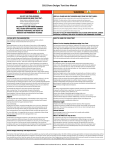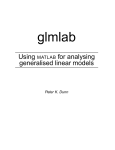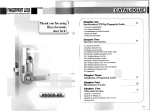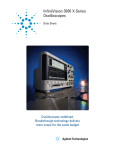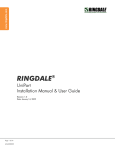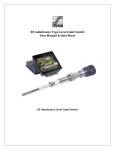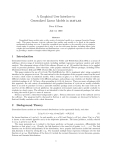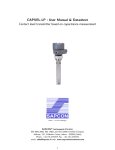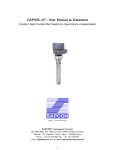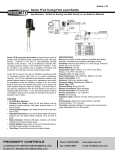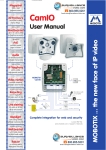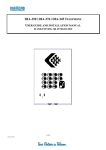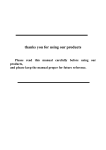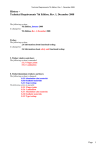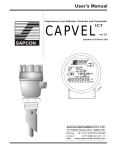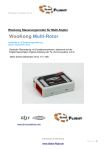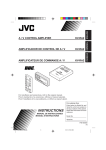Download User Manual & Datasheet V 2.3
Transcript
1 Coat-Endure User Manual & Datasheet V 2.3 Contents Revision History . . . . . . . . . . . . . . . . 1 Introduction . . . . . . . . . . . . . . . . . 2 Operating Principle . . . . . . . . . . . . . 3 Features . . . . . . . . . . . . . . . . . . . 4 Dimesional Layout . . . . . . . . . . . . . . 5 Technical Specifications . . . . . . . . . . . 5.1 Electrical Specifications . . . . . . . . . 5.2 Mechanical Specifications . . . . . . . . 6 Installation Guidlines . . . . . . . . . . . . 6.1 Procedure for Installation . . . . . . . . 6.2 Tank Mounting Installations . . . . . . 6.3 Electrical connections . . . . . . . . . . 7 Calibration & Settings . . . . . . . . . . . . 7.1 Calibration for non-conductive materials 7.2 Calibration for conductive materials . . 7.3 Sensitivity Adjustment . . . . . . . . . 7.4 COVER Delay . . . . . . . . . . . . . . 7.5 UNCOVER Delay . . . . . . . . . . . . 7.6 Fail-safe Selection . . . . . . . . . . . . 7.7 Error Indication . . . . . . . . . . . . . 7.8 Maintanence . . . . . . . . . . . . . . . R Sapcon Instruments Pvt.Ltd. . . . . . . . . . . . . . . . . . . . . . . . . . . . . . . . . . . . . . . . . . . . . . . . . . . . . . . . . . . . . . . . . . . . . . . . . . . . . . . . . . . . . . . . . . . . . . . . . . . . . . . . . . . . . . . . . . . . . . . . . . . . . . . . . . . . . . . . . . . . . . . . . . . . . . . . . . . . . . . . . . . . . . . . . . . . . . . . . . . . . . . . . . . . . . . . . . . . . . . . . . . . . . . . . . . . . . . . . . . . . . . . . . . . . . . . . . . . . . . . . . . . . . . . . . . . . . . . . . . . . . . . . . . . . . . . . . . . . . . . . . . . . . . . . . . . . . . . . . . . . . . . . . . . . . . . . . . . . . . . . . . . . . . . . . . . . . . . . . . . . . . . . . . . . . . . . . . . . . . . . . . . . . . . . . . . . . . . . . . . . . . . . . . . . . . . . . . . . . . . . . . . . . . . . . . . . . . . . . . . . . . . . . . . . . . . . . . . . . . . . . . . . . . . . . . . . . . . . . . . . . . . . . . . . . . . . . . . . . . . . . . . . . . . . . . . . . . . . . . . . . . . . . . . . . . . . . . . . . . . . . . . . . . . . . . . . . . . . . . . . . . . . . . . . . . . . . . . . . . . . . . . . . . . . . . . . . . . . . . . . . . . . . . . . . . . . . . . . . . . . . . . . . . . . . . . . . . . . . . . . . . . . . . . . . . . . . . . . . . . . . . . . . . . . . . . . . . . . . . . . . . . . . . . . . . . . . . . . . . . . . . . . . . . . . . . . . . . . . . . . . . . . . . . . . . . . . . . . . . . . . . . . . . . . . . . . . . . 4 5 5 5 5 5 5 5 5 5 6 7 7 7 7 8 9 9 9 9 10 2 Coat-Endure User Manual & Datasheet V 2.3 List of Figures 1 2 3 5 4 Dimensional Layout: Front View . . Dimensional Layout - Top Mounting Dimensional Layout - Side Mounting Electrical Top panel . . . . . . . . . Electrical Connections . . . . . . . . R Sapcon Instruments Pvt.Ltd. List of Tables . . . . . . . . . . . . . . . 5 6 7 7 8 2 3 4 5 Electrical Specifications . Mechanical Specifcations Switching Sensitivity . . . Error Indications . . . . . . . . . . . . . . . . . . . . . . . . . . . . . . . . . . . . . . 6 . 6 . 9 . 10 3 Coat-Endure User Manual & Datasheet V 2.3 Revision History Revision 1.0 1.1 1.2 2.0 2.1 2.2 2.3 Date 22 Jan,2014 22 Feb, 2014 25 Mar, 2014 20 Apr, 2014 25 Apr, 2014 10 May, 2014 23 April, 2015 Author(s) MRK1 RND1 RND1 RND1 RND1 RND1 RND2 R Sapcon Instruments Pvt.Ltd. Description created Connection diagrams udpated DIP switch position in diagrams updated Header Correction Version Control Conductive Coat-Endure Connection Diagrams updated as per Omni-box insert 4 Coat-Endure 1 User Manual & Datasheet V 2.3 Introduction Coat-Endure is a microcontroller based compact coat immune capacitance level limit switch. It is a compact level switch which is suitable for sticky solids, pastes and slurries. The device is specially suited for compact silos and packaging machines where material has a tendency to stick on the probe. 2 Operating Principle Coat-Endure is an improvement over traditional principle of admittance. The ring type probe has an alternating active and an inactive region, which collectively help the controller to calculate the extent of coating on the probe. In effect, the device is able to identify the differential coating between the sense and the shield by measuring their individual capacitances. As the coating immunity is controlled by the on-board microcontroller, the extent of coating immunity can be set easily. Figure 1: Dimensional Layout: Front View 3 Features • Universal Power Supply of 18-55 V DC & 90-265 V AC on the same terminal. • Compact and customizable probe size. • Passive shielding compensation with adjustable coating immunity. • Output options: Relay,PNP & Analog. • High temperature probe suitable for applications up to 200 Deg C. • Self-diagnosis for probe and electronics. • Popular with a wide range of materials: low-to-high dielectric conductive materials 4 Dimesional Layout Dimensional drawing for a probe length of 100 mm is shown in Figure 1. The dimensions shown in Figure 1 can vary depending on the probe length and the mounting arrangment. A dimensional drawing for your order can be made avaliable on request. 6 Installation Guidlines 6.1 Procedure for Installation For quick and easy installation,follow the steps in the order mentioned below: 1. Testing Electrical Connections: Before mounting the device on the tank, understand and test the connections outside the tank for at least one piece. For details on connections, refer to Figure 4 before connecting the device to outputs and power supply. 2. Mouting the Device: Correct mounting of the instrument is critical to the operation of the instrument. Please refer to Tank Mounting Installation to mount the instrument in the tank/silo or hopper. Coat-Endure is designed to work properly in metal-body tanks only, e.g. MS, SS or Aluminium tanks. Performance in plastic tanks might not be satisfactory. 3. Electrical Connections: Perform the electrical connections as mentioned earlier in Step 1. 4. Calibration and Settings: 5 Technical Specifications 5.1 Electrical Specifications For electrical specfications please refer to Table 2. 5.2 Mechanical Specifications Please refer to Table 3 for mechanical specifications. 1 Mininmum switching time could vary depending on the dielectric constant of the application material R Sapcon Instruments Pvt.Ltd. • For non-conductive materials, Coat-Endure can be calibrated in an empty process tank without the application material. • If the application material is conductive, CoatEndure has to be calibrated with the material. Time-delay and fail-safe selection should be done afer this stage. Section Calibration and Settings covers settings in more detail. 5 Coat-Endure Parameter Input Power Supply Output (any one) Switching Switching Indication Current Consumption Fail safe Delay Setting Relay Rating User Manual & Datasheet V 2.3 Value 18-55V DC/90-265V AC (on same terminal) • Relay SPDT • Relay DPDT • Open Collector - PNP output • Analog 8/16 mA Single-point level switching Bi-color LED • Red for Alarm • Green for Normal 50mA max. at 18V DC with load Field selectable (min. failsafe: low, max. fail-safe: high) Covered and Uncovered Delays: 1-25 sec 1 6 Amps Table 2: Electrical Specifications 5. Trial Run: Perform a trail run of the application process with the application material. In case of errors or unsatisfactory output, refer to Section Error Indications. Parameter Housing Cable Entry Operating Temprature High Temperature Operating Pressure Mounting Dimensions Insulation Value Pressure Die Cast: aluminium 2 x 1/2“ BSP/NPT, PG 13.5 0◦ C to +60◦ C (Electronics) • 100◦ C for standard probe • 200◦ C for probe with standoff pipe Up to 10 bar 1” BSP / NPT Threaded Flange mouting as per user specification Refer to GA Drawing Part PTFE / Full PTFE Table 3: Mechanical Specifcations heat shield should be fitted above the instrument especially if the operating temperature lies between 60◦ C and 80◦ C. • Grounding part (SS material) of the probe should be exposed at least 20mm inside the hopper after threading / nozzle. 6. Finishing the Installation: Tighten the lid and the cable entries on the instrument so that no moisture seeps into the instrument. 6.2 Tank Mounting Installations • Coat-Endure is designed to work in metal-body tanks only, e.g. MS, SS or Aluminium tanks. Performance in plastic tanks might not be satisfactory. • The Coat-Endure probe (see figure 1)can be installed in the vessel in both horizontal (side mounting) and vertical (top mounting) positions. Please refer to Figures 2 and 3. • To prevent the ingress of moisture and water seepage in side mounting position, the cable entries should always point downwards. • Weatherproofness of enclosure is guaranteed only if the cover is in place and glands are adequately tightened. Damage due to accidental entry of water can be avoided if the instrument is installed in a rain shade. • If the ambient temperature is high, the instrument should not be installed to receive direct sunlight. In case such a position of shade is not available, a R Sapcon Instruments Pvt.Ltd. Figure 2: Dimensional Layout - Top Mounting 6 Coat-Endure User Manual & Datasheet V 2.3 Coat-Endure NORMAL 24-55 VDC 90-265 VAC L + 1 N -2 E 3 OPEN COVER UNCOV CALIBRATE FAILSAFE PNP RELAY-1 NC 4 C 5 NO 6 + - 7 8 ENTER OUT RS485 9 10 V-2.0 ALARM Figure 5: Electrical Top panel acid based pastes, etc.), Coat-Endure needs to be calibrated with the application material. This will make the instrument specific to the application material i.e. if the application material is changed; calibration should be repeated. Note: Calibration in air is specfic to the tank, if the tank changes, the instrument needs to be calibrated again. Figure 3: Dimensional Layout - Side Mounting 7.1 Calibration for non-conductive materials 6.3 Electrical connections Electrical connections for the instrument will change with the models. Please refer to Figure 4 and the precautions mentioned below before connecting the device. Precautions for connecting Coat-Endure • Power Supply Rating Make sure the power supplied to the instrument is within the specified range mentioned in Table 2. • Connect Earth When supplying AC power, please make sure that the grounding screw on the housing and the earth terminal are all connected to the plant’s earth. • Power Supply Fluctuations & Noise External noise or flucating power supplies could affect performace and shorten the life of the instrument. Use external line suppressors and fuse wires to contain the risk of damage to the circuit. Coat-Endure needs to be calibrated inside the empty process tank (i.e only air, no material). Calibrating the instrument outside the tank can cause malfunctions. Once calibrated inside the empty tank, Coat-Endure can operate with a wide range of application materials without the need of changing its default senstivity settings. 1. Make sure that all DIP switches are in the Open position. 2. To start with the calibration, set the CALIB switch to close position.(Close is opposite of OPEN for DIP switch) 3. Make sure that the Status LED is not blinking. A blinking LED here indicates Error. 4. Then press ENTER, the Status LED will blink once in RED color. 5. Now set the CALIB switch back to OPEN position. 7 Calibration & Settings The DIP switches for calibration and settings can be accesed by opening the top aluminium cover. Refer to Figure 5 for information on DIP swtiches Procedure for calibration Coat-Endure depends on the conductivity of the application material: 6. Air calibration for Coat-Endure is now complete. Now, test the calibration by filling in the material or draining it out from the tank. Repeat the filling and draining to confirm proper operation of the device. Note: For certain application materials, CoatEndure might need an adjustment to its settings. Refer to Section Sensitivity Adjustment for more details. • Calibration for non-conductive materials Calibration should be done without the application material. Once calibrated in the empty tank, the device can be used with a wide range of non-conductive materials. 7.2 Calibration for conductive materials • Calibration for conductive materials For applications using conductive materials (water, Fill the tank with the application material such that the probe is completely covered with the material. R Sapcon Instruments Pvt.Ltd. 7 Coat-Endure 24 TO 55VDC Relay Contacts (Potential Free) Pin No. Line (+) 1 Neutral (-) 2 Earth Earth 3 Alarm position for covd. in high failsafe Alarm position for uncov. in low failsafe Status LED 90 TO 265VAC User Manual & Datasheet V 2.3 RED No. 6 ALARM Pole(C) 5 GREEN NORMAL High failsafe : FAILSAFE switch open Low failsafe : FAILSAFE switch closed (a) Powering the device NC 4 (b) Relay Connections Pin PNP Output (Internally Isolated) Condition PNP Pin NO Alarm OFF RED Normal ON GREEN Above applies irrespective of falisafe No. - LED 8 9 PNP- collector output can drive loads upto 90mA at 24V. (c) PNP(isolated) output connections Figure 4: Electrical Connections Connection Diagrams for different outputs are mentioned above. As per your model, select a connection diagram and connect the device. 1. Make sure that all DIP switches are in the Open position. 2. To start with the calibration, set the CALIB and COVER switches to close position.(Close is opposite of OPEN for DIP switch) sensitivity is set to 3 to suit a wide range of materials. Traverse the following steps to set the sensitivity of CoatEndure 1. Select a sensitivity value for the instrument as per Table 4. 3. Make sure that the Status LED is not blinking, a blinking LED here indicates Error. 2. Set the CALIB switch to CLOSE position. 4. Then press ENTER, the Status LED will blink once in RED color. 4. PRESS and HOLD the ENTER key, the status LED will start blinking. 5. Now set the CALIB and COVER switch back to OPEN position. 5. The first blink leaves the sensitivity value unchanged. 6. Calibration for Coat-Endure is now complete. 6. Start counting from the next blink upto the selected sensitivity value. Now, test the calibration by filling in the material or draining it out from the tank. Repeat the filling and draining to confirm proper operation of the device. Note: For certain conductive application materials, Coat-Endure might need an adjustment to its settings. Refer to Section Sentivity Adjustment for more details. 7.3 Sensitivity Adjustment The instrument has 5-point sensitivity level to suit a wider range of application materials. Sensitivity value should be decided with respect to the dielectric constant and coating thickness of the application material. Refer to Table 4 for selecting a suitable value. By default, the R Sapcon Instruments Pvt.Ltd. 3. Also switch the UNCV switch to CLOSE position. 7. Set the CALIB and UNCV switches back to OPEN position. 8. Check operation of Coat-Endure by filling in and draining out the material. 9. If the instrument does not switch when covered fully with the material, try again with a higher value of sensitivity. 10. If the instrument switches when covered fully with the material, but does not switch back to normal state when uncovered, try again with a lower sensitivity value. Factory Reset To reset time delays and sensitivity values to default values, follow the following steps: 8 Coat-Endure User Manual & Datasheet V 2.3 Application Material Properties Dielectric Const. High Low High Low Coating Thickness High High Low Low Sensitivity Value 1−3 3 − 5(default) 1−2 5 Table 4: Switching Sensitivity 1. Set the CALIB, COV and UNCOV switches to CLOSE position 2. PRESS and HOLD the ENTER key until the status LED blinks. 3. Switch the CALIB, COV and UNCOV switches back to OPEN position. 4. This will set the time delay to 0 and the sensitivity level to 3. 7.4 COVER Delay When material covers the Coat-Endure probe, the changeover of the output can be delayed by a predetermined time. This time is called COVER Delay. Follow the steps mentioned below to set the COVER delay to 2 seconds. 1. To set the uncover delay, set the UNCOV switch to close position. 2. Make sure that the status LED is not blinking for Error. Then press ENTER and keep it pressed. 3. The Status LED will blink. Count the number of blinks of the LED.To Set a delay pf two seconds, two Blinks will be required. After two blinks, release the ENTER key. 4. Uncover Delay is entered, but not saved. To save and test the uncover delay, set the cover switch back to open position. 5. To test, dip the probe into the material until the switching point is achieved. 6. Coat-Endure will start blinking RED if the switch point is reached. It will blink for the number of seconds for which the uncover delay is set. 7. Now, remove the probe from the material until the other switch point is acheived. The Status LED will start blinking GREEN to indicate that the uncover switch point is reached. It will blink for the number of seconds for which the uncover delay is set. 7.6 Fail-safe Selection 1. To set the cover delay, set the COVER switch to close position. In Coat-Endure, fail-safe is applied as soon as its DIP switch is set for the required fail-safe operation. When fail-safe is set to HIGH (default) - Fail-safe switch is OPEN : 2. Make sure that the Status LED is not blinking for Error. 1. Relay ON - When not in contact with the material, LED turns RED. 3. Then press ENTER and keep it pressed. The Status LED will Blink. 2. Relay OFF - When in contact with the material, LED turns GREEN. 4. Count the blinks of the LED. To Set a delay two seconds, two blinks will be required. After two blinks, release the ENTER key. When fail-safe is set to LOW : The operation is reversed - Fail-safe switch is CLOSED. 5. Delay is entered, but not saved. 6. To save and test the cover delay, set the cover switch back to open position. 7. To test, dip the probe into the material until the switching point is reached. Coat-Endure will start blinking RED if the switch point is reached. It will blink for the number of seconds for which the cover delay is set. 1 Blink is equal to 1 second during switching. A maximum of 25 seconds can be set. 7.5 UNCOVER Delay When the material uncovers the Coat-Endure probe, the changeover of the output can be delayed by a predetermined time. This time is called the UNCOVER Delay. Follow the steps mentioned below to set the UNCOVER delay to 2 seconds. R Sapcon Instruments Pvt.Ltd. 1. Relay ON - When in contact with the material, LED turns RED. 2. Relay OFF - When not in contact with the material, LED turns GREEN. Irrespective of the fail-safe value, the color of the blinking LED when the cover and uncover delays are SET will be: • RED: Cover Delay • GREEN: Uncover Delay 7.7 Error Indication In Coat Endure, errors are indicative of operators mishandling of the instrument. These are provided to ensure proper setting and protection of the instrument. 9 Coat-Endure User Manual & Datasheet V 2.3 LED Error Indication RED-GREEN Blinking Description Troubleshooting Calibration Error RED blinking Probe short-circuit GREEN Blinking Probe Open 3 times GREEN Blinking & one Red Blink 3 times RED Blinking & one GREEN Blink Illegal Key combination Recalibrate the instrument, make sure that the probe is calibrated in an empty metal-body tank. Moisture deposition in the probe connector. Clean the connector and use the instrument. Remove the electronic insert from the housing and check the cable connections of the probe. Switch all DIP switches to open position. Use only legal combination of keys. Contact the Customer Support department at Sapcon. Circuit Error Table 5: Error Indications Error Indication: On error, the Status LED starts blinking RED and GREEN alternately at a faster rate. Normal LED blinks are always at the rate of 1 blink per second, in either RED or GREEN colour. In some cases, a GREEN or a RED blinking could indicate an error. Refer to Table 5 for a list of errors and their indication. Nature of error: 1. Incomplete calibration 7.8 Maintanence The electronics of this instrument needs no maintenance. When cleaning and checking the vessel, free the tuning probe from deposits. If the material has a tendency to form a hard sticky deposit, then the instrument must be checked more often. Make sure that the cable ducts and the lid are tightly sealed so that no moisture seeps into the instrument. 2. Low capacitance To avoid errors: 1. Always complete the calibration by putting the CALIB switch back to OPEN position. This can be done within 2 minutes of releasing ENTER for the last time for calibration purpose. 2. Always complete the delay settings by putting the DELAY switches back to OPEN position. This can be done within 2 minutes of releasing the ENTER for DELAY setting purpose. 3. Make sure that only 1 one switch is at the CLOSE position amongst the CALIB, COVER and UNCOV switches . Fail-safe switch can be OPEN or CLOSE and is not a source of error. Resetting Error: 1. Bring the CALIB, COVER and UNCOV switches to OPEN position. 2. Press the ENTER key. 3. LED alternate color blinking will STOP. R Sapcon Instruments Pvt.Ltd. 10











